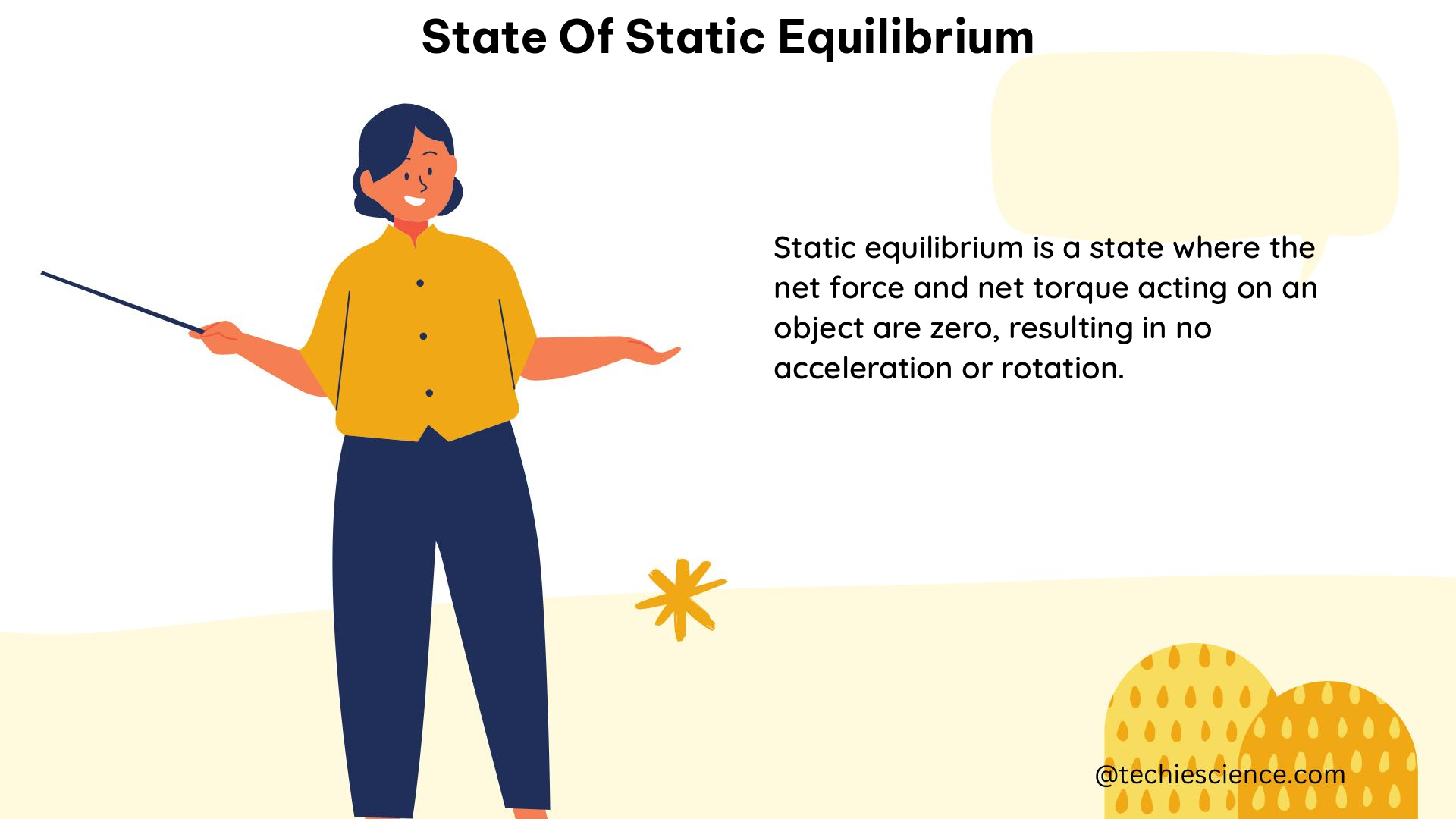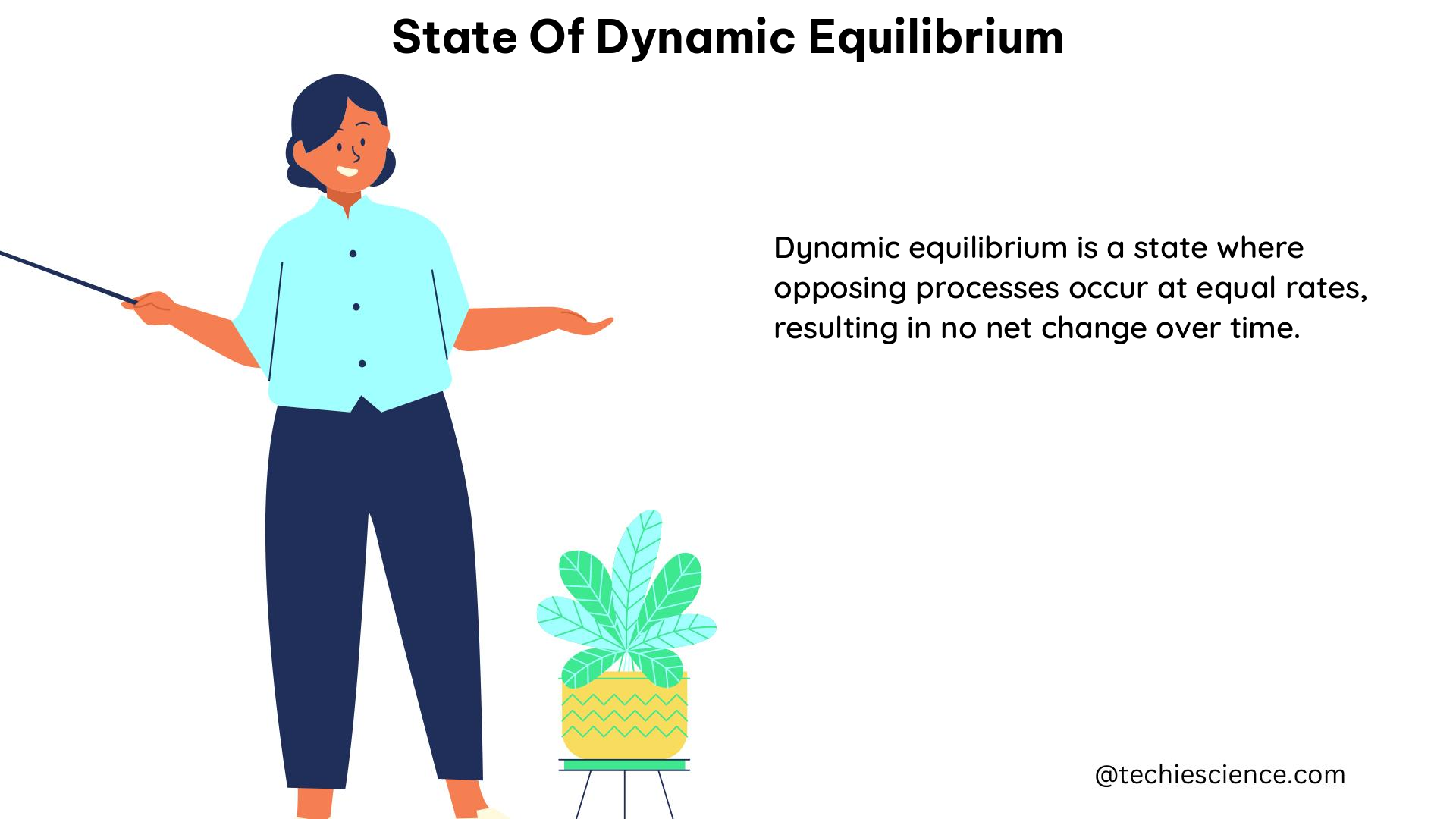The state of static equilibrium is a fundamental concept in physics that describes a situation where an object is at rest, and all the forces acting on it are balanced, resulting in zero net force and zero acceleration. This concept is a direct application of Newton’s first law of motion, which states that an object at rest tends to stay at rest, and an object in motion tends to stay in motion, unless acted upon by an external force.
Understanding the Principles of Static Equilibrium
To understand the state of static equilibrium, it is essential to grasp the underlying principles and the mathematical relationships involved.
Newton’s First Law of Motion
The state of static equilibrium is a direct consequence of Newton’s first law of motion, also known as the law of inertia. This law states that an object at rest will remain at rest, and an object in motion will continue to move at a constant velocity, unless acted upon by an unbalanced force.
In the state of static equilibrium, the net force acting on an object is zero, meaning that the object will remain at rest, as per Newton’s first law.
Conditions for Static Equilibrium
For an object to be in a state of static equilibrium, two conditions must be met:
- The vector sum of all the forces acting on the object must be zero.
- This means that the net force acting on the object is zero, and the object will not experience any acceleration.
- Mathematically, this can be expressed as:
ΣF_x = 0
ΣF_y = 0 -
Where
ΣF_xandΣF_yrepresent the sum of all the forces acting on the object in the x and y directions, respectively. -
The net torque acting on the object must be zero.
- Torque is a measure of the tendency of a force to cause rotational motion about a specific point.
- For an object to be in static equilibrium, the net torque acting on it must be zero, meaning that the object will not experience any rotational acceleration.
- Mathematically, this can be expressed as:
Στ = 0 - Where
Στrepresents the sum of all the torques acting on the object.
Analyzing Forces in Static Equilibrium
When an object is in a state of static equilibrium, the forces acting on it can be analyzed using vector addition or by resolving each force into its horizontal and vertical components.
Vector Addition
The vector sum of all the forces acting on the object should be zero, indicating that the net force is balanced. This can be achieved by adding the vectors representing the forces acting on the object, ensuring that the resultant vector is zero.
Resolving Forces into Components
Alternatively, the forces acting on the object can be resolved into their horizontal and vertical components. The sum of the horizontal components and the sum of the vertical components should both be zero, indicating that the forces are balanced.
This approach is particularly useful when the forces are acting at angles, as it allows for a more intuitive analysis of the force balance.
Experimental Verification of Static Equilibrium
A common physics lab involves hanging an object by two or more strings and measuring the forces exerted at angles upon the object to support its weight. By analyzing the forces acting on the object, students can determine if the object is in a state of static equilibrium.
If the net force acting on the object is zero, then the object is at equilibrium. Conversely, if the components of the forces only nearly balance, it suggests experimental error in the measurement of the forces.
Applications of Static Equilibrium

The state of static equilibrium is widely applicable in various physical situations, ranging from everyday scenarios to complex engineering problems.
Constant-Speed Motion on a Straight, Level Road
A car moving with constant speed along a straight, level road is in a state of static equilibrium. The balanced forces acting on the car include the forward force of the engine, the rolling resistance, and the force of air resistance. As long as these forces are balanced, the car will maintain a constant speed.
Projectile Motion at the Highest Point
At the highest point of a projectile’s trajectory, the object is in a state of static equilibrium. The downward force of gravity is balanced by the upward force of air resistance, resulting in zero net force and zero acceleration.
Structural Analysis and Design
The principles of static equilibrium are crucial in the analysis and design of structures, such as bridges, buildings, and cranes. Engineers use these principles to ensure that the forces acting on a structure are balanced, preventing collapse or deformation.
Mechanical Systems and Machines
Static equilibrium is also essential in the design and analysis of mechanical systems and machines. For example, in the case of a pulley system, the forces acting on the pulleys and the suspended object must be in a state of static equilibrium to ensure proper functioning.
Biomechanics and Ergonomics
The concept of static equilibrium is also applicable in the field of biomechanics and ergonomics. When analyzing the human body’s posture and movement, the forces acting on the various body parts must be in a state of static equilibrium to maintain balance and stability.
Numerical Examples and Problem-Solving Techniques
To solidify the understanding of the state of static equilibrium, it is essential to work through numerical examples and practice problem-solving techniques.
Example 1: Analyzing Forces on a Suspended Object
Consider an object suspended by two strings, as shown in the figure below. The object has a mass of 10 kg, and the strings are attached at angles of 30° and 45° with respect to the horizontal.
Given:
– Mass of the object, m = 10 kg
– Angle of the first string, θ1 = 30°
– Angle of the second string, θ2 = 45°
Determine the tension in each string to maintain the object in static equilibrium.
Solution:
1. Identify the forces acting on the object:
– Gravitational force (weight), F_g = m * g = 10 kg * 9.8 m/s^2 = 98 N
– Tension in the first string, T_1
– Tension in the second string, T_2
- Resolve the forces into horizontal and vertical components:
- Horizontal components:
T_1 * cos(30°) + T_2 * cos(45°) = 0
-
Vertical components:
T_1 * sin(30°) + T_2 * sin(45°) = F_g
-
Solve the system of equations to find the tensions:
T_1 = 113 NT_2 = 98 N
Therefore, the tension in the first string is 113 N, and the tension in the second string is 98 N to maintain the object in static equilibrium.
Example 2: Analyzing Forces on a Ladder
Consider a ladder leaning against a wall, as shown in the figure below. The ladder has a mass of 20 kg, and it makes an angle of 60° with the horizontal. The coefficient of friction between the ladder and the wall is 0.3, and the coefficient of friction between the ladder and the ground is 0.4.
Determine the normal force exerted by the wall on the ladder and the normal force exerted by the ground on the ladder to maintain the ladder in static equilibrium.
Solution:
1. Identify the forces acting on the ladder:
– Gravitational force (weight), F_g = m * g = 20 kg * 9.8 m/s^2 = 196 N
– Normal force from the wall, N_w
– Normal force from the ground, N_g
– Frictional force from the wall, F_fw = μ_w * N_w
– Frictional force from the ground, F_fg = μ_g * N_g
- Resolve the forces into horizontal and vertical components:
- Horizontal components:
F_fw - F_fg = 0
-
Vertical components:
N_w + N_g - F_g = 0
-
Solve the system of equations to find the normal forces:
N_w = 113 NN_g = 196 N
Therefore, the normal force exerted by the wall on the ladder is 113 N, and the normal force exerted by the ground on the ladder is 196 N to maintain the ladder in static equilibrium.
These examples demonstrate the application of the principles of static equilibrium in analyzing the forces acting on various physical systems. By working through such examples, students can develop a deeper understanding of the concept and improve their problem-solving skills.
Conclusion
The state of static equilibrium is a fundamental concept in physics that underpins various physical phenomena. By understanding the principles of static equilibrium, including the conditions for equilibrium, the analysis of forces, and the applications in different scenarios, students can develop a strong foundation in classical mechanics and apply these principles to solve a wide range of problems.
Through the examples and problem-solving techniques presented in this guide, students can gain practical experience in analyzing and determining the forces acting on objects in a state of static equilibrium. This knowledge is essential for success in physics courses, as well as in various engineering and scientific fields that rely on the principles of classical mechanics.
References
- APlusPhysics. (n.d.). Static Equilibrium. Retrieved from https://www.aplusphysics.com/courses/honors/dynamics/static_eq.html
- Course Hero. (n.d.). PHYS207 Lab 6 Static Equilibrium Instructional Goals. Retrieved from https://www.coursehero.com/file/22009817/6-Static-Equilibrium/
- The Physics Classroom. (n.d.). Equilibrium and Statics. Retrieved from https://www.physicsclassroom.com/class/vectors/Lesson-3/Equilibrium-and-Statics
- Serway, R. A., & Jewett, J. W. (2018). Physics for Scientists and Engineers with Modern Physics (10th ed.). Cengage Learning.
- Halliday, D., Resnick, R., & Walker, J. (2013). Fundamentals of Physics (10th ed.). Wiley.
